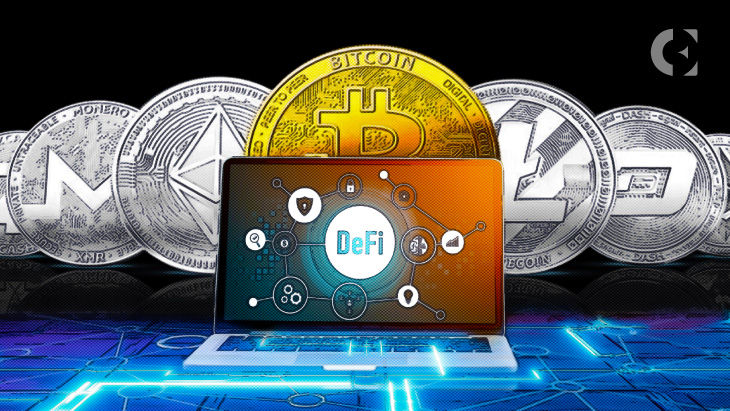What is DeFi?
Let’s break this down for you.
Decentralized Finance, commonly called DeFi, is an evolving financial technology based on secure ledgers similar to those used by cryptocurrencies. It gives you control and visibility of your finances and exposure to global markets and alternatives for your banking options. DeFi products are serviceable for anyone with an internet connection and are maintained by their users.
Take a look at some key features that DeFi offers:
- This technology terminates the fees that banks and other financial organizations ask for its services.
- Your money is secured using a digital wallet.
- The wallet can be accessed by anyone with an internet connection.
- You can transfer funds in no time.
What Makes Decentralized Finance (DeFi)?
DeFi hit its peak in 2020, bringing a surge of projects into the crypto markets and popularizing a new financial movement. Decentralized and crypto finance ecosystems gained momentum after 2017, popularizing additional financial capabilities.
In 2020, the DeFi niche took off as other platforms surfaced, in line with people using DeFi solutions for strategies such as yield farming.
Understanding DeFi
To understand decentralized finance and how it works, it helps to identify how centralized finance varies from decentralized finance.
Centralized Finance
In centralized finance, your assets are held by banks and other organizations. The financial system is full of third-party companies who simplify money transactions between parties who charge fees for providing their services.
Decentralized Finance
Decentralized finance removes mediators by allowing people, dealers, and businesses to carry out financial transactions through upcoming technologies. This is achieved through peer-to-peer (P2P) financial networks that use security evidence, connectivity, software, and hardware functions. You can lend, trade, and borrow money using software that records and verifies financial actions from anywhere using just an internet connection.
Functions of DeFi
Although DeFi is frequently mentioned with cryptocurrencies, it goes way beyond the boundaries of new digital currencies. Its smart contracts are designed to replace traditional financial systems.
No banks or institutions are involved in accounting for your money as there are no mediators to authorize transactions for these applications. There are multiple software available for users, most of which have been built using the Ethereum network.
Risks of Using DeFi?
The decentralized finance space remains an emerging market that still faces some flaws. DeFi is yet to reach its desired level of adoption, and for it to do so, blockchains must become more stable. Blockchain infrastructure is still in its early form, most of which is inefficient for developers and users alike.
On some platforms, transactions move at a slow pace, and this will probably continue to be the case until the dependability improves. Fiat on-ramps (a service that facilitates the exchange of fiat money to cryptocurrencies) to DeFi platforms can also be slow, which dampens user adoption.
DeFi has grown leaps and bounds in the past years. Given its youth and innovation, the legal details around DeFi have not yet fully emerged. Governments across the globe may aim to fit their current regulatory guidelines onto DeFi, or they may construct new laws on the sector. Regardless DeFi and its users may already be subject to specific regulations in some regions.
Uses of DeFi
DeFi is creating an impact in a wide variety of simple and complex financial transactions. It is engineered by decentralized apps (dApps), or other programs called protocols. dApps and protocols handle transactions in two cryptocurrencies, namely Bitcoin (BTC) and Ethereum (ETH).
While Bitcoin is the more commonly used cryptocurrency among the masses, Ethereum is much more applicable for a wider variety of uses. Most of the dApp and protocol landscape use the Ethereum-based code.
Take a look at some of the ways dApps and protocols are used:
- Traditional Financial Transactions. DeFi provides a channel for anything, including payments, trading securities, and insurance to lending and borrowing.
- Stablecoins. While cryptocurrencies are notably volatile, stablecoins attempt to stabilize their values by linking them to non-digital currencies, like the USD and Sterling Pounds.
- Yield Harvesting. An emerging financial technology that aims to remove intermediaries in financial transactions, has opened up multiple channels of income for investors. Yield farming involves staking your cryptocurrencies to be rewarded in the form of transaction fees.
- Non-Fungible Tokens (NFTs). NFTs create digital assets out of typically non-tradable assets, like videos of basketball shots or Twitter tweets.
- Flash Loans. These are cryptocurrency loans that borrow and return funds in the same transaction. Sounds surreal, right? Here’s how it works: borrowers have the potential to make money by entering into a contract encoded on the Ethereum blockchain that borrows funds, executes a transaction, and repays the loan instantly. If the transaction cannot be executed or may incur a loss, the funds will be sent to the loaner automatically.
- Decentralized Exchanges (DEXs). Currently, most cryptocurrency investors use centralized exchanges like Coinbase or Gemini. DEXs facilitate peer-to-peer financial transactions and let users maintain control over their funds.
- E-wallets. DeFi developers are creating digital wallets that can independently operate cryptocurrency exchanges. This will allow investors to gain access to everything from cryptocurrency to blockchain-based technologies.
Prevailing Risks in DeFi Investments
Basically, the smaller the capitalization is, the riskier the investment is. Therefore, it is recommended to look at the liquidity of tokens before investing your funds. Ensure you know how long a DeFi protocol has been operating and how much money it has in total deposits before investing.
Learn More About Crypto, Blockchain, & Web3:
- What Is Ethereum: Complete Guide to the 2nd Largest Blockchain Project
- Explaining Ethereum Name Service (ENS): What Is It and How Does It Work?
- Ethereum vs Bitcoin: Use Cases, Technical Differences, Scaling Issues
- Web3 vs Web2 : What’s the Difference?
Disclaimer: The information presented in this article is for informational and educational purposes only. The article does not constitute financial advice or advice of any kind. Coin Edition is not responsible for any losses incurred as a result of the utilization of content, products, or services mentioned. Readers are advised to exercise caution before taking any action related to the company.







